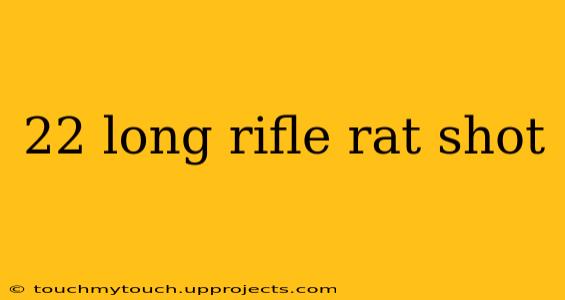The .22 Long Rifle (LR) cartridge is a popular choice for pest control, particularly for rats. Its affordability, availability, and relatively low recoil make it accessible to many, but understanding its effectiveness and limitations is crucial for humane and successful rat eradication. This guide will delve into the specifics of using a .22 LR for rat control, covering ammunition selection, ethical considerations, and practical shooting techniques.
Why .22 LR for Rats?
The .22 LR's popularity in rat control stems from several key advantages:
- Cost-Effectiveness: .22 LR ammunition is significantly cheaper than many other calibers, making it a budget-friendly option for dealing with rat infestations.
- Low Recoil: The gentle recoil makes it easier to handle, especially for beginners or those with less upper body strength, allowing for more accurate follow-up shots.
- Quiet Operation (with subsonic ammo): Subsonic .22 LR ammunition produces significantly less noise than supersonic rounds, making it ideal for urban environments or situations where minimizing noise is paramount. This is important to avoid startling the rats and compromising your hunting strategy.
- Accuracy: With the right firearm and ammunition, the .22 LR is capable of impressive accuracy at typical rat-control ranges.
Choosing the Right Ammunition
Not all .22 LR ammunition is created equal. When choosing ammo for rat control, consider the following:
- Hollow Points: Hollow point bullets expand upon impact, creating a larger wound cavity and increasing stopping power. This is generally preferred for humane dispatch.
- High-Velocity vs. Subsonic: High-velocity rounds offer greater range and penetration but produce more noise. Subsonic rounds are quieter but have slightly less stopping power at longer distances. The choice depends on your environment and shooting conditions.
- Solid Points: While less effective at expanding, solid point ammunition can be useful when shooting through light obstacles.
Important Note: Always prioritize humane dispatch. Choose ammunition that will reliably incapacitate the rat quickly and minimize suffering.
Ethical Considerations
Using any firearm for pest control requires responsibility and ethical considerations:
- Accuracy: Ensure you can accurately hit your target before taking a shot. Missing can injure or scare the rats, potentially making them harder to control.
- Safety: Always follow firearm safety rules. Never point a firearm at anything you don't intend to shoot, and keep your finger off the trigger until you are ready to fire.
- Collateral Damage: Be mindful of the surroundings. Avoid shooting in areas where stray bullets could pose a risk to people, pets, or property.
- Local Regulations: Check your local laws and regulations regarding firearm use and pest control.
Practical Shooting Techniques
Effective rat control with a .22 LR requires proper technique:
- Headshots: Aim for a headshot for the most humane and effective kill.
- Patience: Rats are often elusive. Patience and observation are crucial for successful hunting.
- Appropriate Lighting: Proper lighting is essential for accurate shot placement, particularly in low-light conditions.
- Stable Platform: Use a stable rest (such as a sandbag or tripod) for improved accuracy.
Alternatives to .22 LR
While the .22 LR is a popular choice, other methods exist for rat control. These include traps, poisons (used with extreme caution and following all instructions), and professional pest control services. Consider the pros and cons of each method before deciding on the best approach for your specific situation.
Conclusion
The .22 Long Rifle can be an effective tool for rat control when used responsibly and ethically. By carefully selecting ammunition, practicing safe firearm handling, and employing proper shooting techniques, you can humanely and effectively manage rat populations. Remember to always prioritize safety and consider alternatives if necessary.
